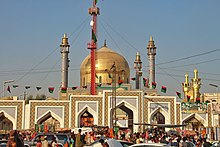Lal Shahbaz Qalandar
Sayed Uthman Marwandi (Lal Shahbaz Qalandar) | |
|---|---|
 | |
| Title | Qalandar, Jhuelal |
| Personal | |
| Born | Sayed Uthman Marwandi 1177[1] |
| Died | 19 February 1274 (aged 96–97)[1] |
| Religion | Islam |
| Parent | Sayyid Ibrahim Kabiruddin al-Jawabi (father)[3] |
| Other names | Lal Shahbaz Qalandar |
| Muslim leader | |
| Based in | Sehwan |
| Period in office | 12th/13th century |
Uthman Marwandi, (1177 - 19 February 1274) popularly known as Lal Shahbaz Qalandar (
Born in
Names
He is called Lal ("ruby-coloured") because he used to wear red color attire, red was his favorite color;[7] "Shahbaz" to denote a noble and divine spirit and "Qalandar" as he was a wandering spiritual man.[1]
Lal Shahbaz Qalandar is sometimes called Jhulelal (Sindhi: جھولےلال).[8][1] The term Jhulelal means "red bridegroom". There are various legends why he was called thus. According to the Garland Encyclopedia, Lal Shahbaz Qalandar was referred to as Jhulelal (red bridegroom) because he was promised marriage to a daughter of his friend, but the friend died and later his friend's son refused to allow the agreed upon marriage, which caused Lal Shahbaz Qalandar to grief.[9][10]
Life
Lal Shahbaz Qalandar, son of Sayyid Ibrahim Kabiruddin al-Jawabi,
A contemporary of
In
This was also the time period when Ghiyas ud din Balban (reigned: 1266 – 1287) ruled India.[3]
It is said Lal Shahbaz Qalandar was a tough ascetic. When he arrived in Sehwan (then Savistan), there was a shaivites cult of ascetics. He joined the ascetics, was engaged in tapasiya and acts of self-mortification like sitting on a cauldron of fire.[10]
The 19th century spiritual Sufi Manqabat Dama Dam Mast Qalandar is dedicated to Lal Shahbaz Qalandar and is widely popular in the sub-continent.
Shrine


The shrine of Lal Shahbaz Qalandar was built by
Mela / Urs (Annual Fair)
Lal Shahbaz's annual
The 2017 terrorist attack
On 16 February 2017, a group claimed responsibility for a
Dhammal
Dhamaal is a mystical dance of Sindh which is mainly performed by faqirs, dervishs, sufi saints and devotees. The Dhammal of Hazrat Lal Shahbaz Qalandar is quite famous. The main performers would wear all red color Jama and Sindhi Patko (turban), the red is the color of Lal Shahbaz Qalandar, which was the favorite color of him, he wore the attire of red color as well, hence the name "Lal" has been given to him which means "Red".[22] Dhammal is characterized by religious fervor. Nagaro, Nobat, Gharyal, Ghugoo instruments etc provide the beat and tempo for the dance.
See also
- Rabia Basri
- 2017 Lal Shahbaz Qalandar Shrine Suicide Bombing
- Bodla Bahar
- Syed Nadir Ali Shah
References
- ^ a b c d e f "The Sufi in red Pakistan Today". archive.pakistantoday.com.pk. Retrieved 11 August 2021.
- ISBN 1576073556.
- ^ a b c d e Lohar, Masood (5 October 2004). "Saint revered by people of all religions". DAWN (newspaper). Retrieved 14 February 2018.
- ^ "Hazrat Lal Shehbaz Qalandar". Aal-e-Qutub Aal-e-Syed Abdullah Shah Ghazi. 18 December 2017. Retrieved 31 March 2023.
- ISBN 978-1-908286-99-4.
- ISBN 0809136198.
- ^ admin (1 January 2012). "Story Of Pakistan | Lal Shahbaz Qalandar". Story Of Pakistan. Retrieved 4 April 2024.
- ISBN 978-0807857892.
- ISBN 9780824049461
- ^ ISBN 978-1-4088-0124-6.
- ^ Qazi Ghulam Shabbir. Aqwal al-Masomin Fi Rad al-Muqasirin (in Urdu). Vol. 1. Pakistan. p. 57.
- RCD Cultural Institute.
- ^ M Inam (1978) Hazrat Lal Shahbaz Qalandar of Sehwan Sharif. Karachi.
- ^ Hasan, Masudul (1965). Hand Book of Important Places in West Pakistan. Lahore: Pakistan Social Service Foundation. p. 21.
- ^ Balfour, Edward (1885). The Cyclopædia of India and of Eastern and Southern Asia, Volume 3. B. Quaritch. p. 562.
- ^ a b Journal of the Asiatic Society of Bengal, Volume 68. Asia: Bishop's College Press. 1899. p. 32.
- ^ Khan, Mohammad Hussain (11 March 2023). "In pictures: Devotees converge on Sehwan as Lal Shahbaz Qalandar's urs begins". DAWN.COM. Retrieved 18 April 2023.
- ^ a b "Pakistan's Sufis defiant after Islamic State attack on shrine kills 83". Reuters News Agency. 17 February 2017. Retrieved 14 February 2018.
- ^ a b "Sehwan bombing toll reaches 88, over 250 injured". The News International (newspaper). 17 February 2017. Retrieved 14 February 2018.
- ^ "In all its glory, Qalandar's urs culminates in Sehwan". The Express Tribune (newspaper). 18 May 2017. Retrieved 14 February 2018.
- ^ "37 terrorists killed in security crackdown after Sehwan bombing". The News International (newspaper). 17 February 2017. Retrieved 14 February 2018.
- ^ admin (1 January 2012). "Story Of Pakistan | Lal Shahbaz Qalandar". Story Of Pakistan. Retrieved 4 April 2024.
